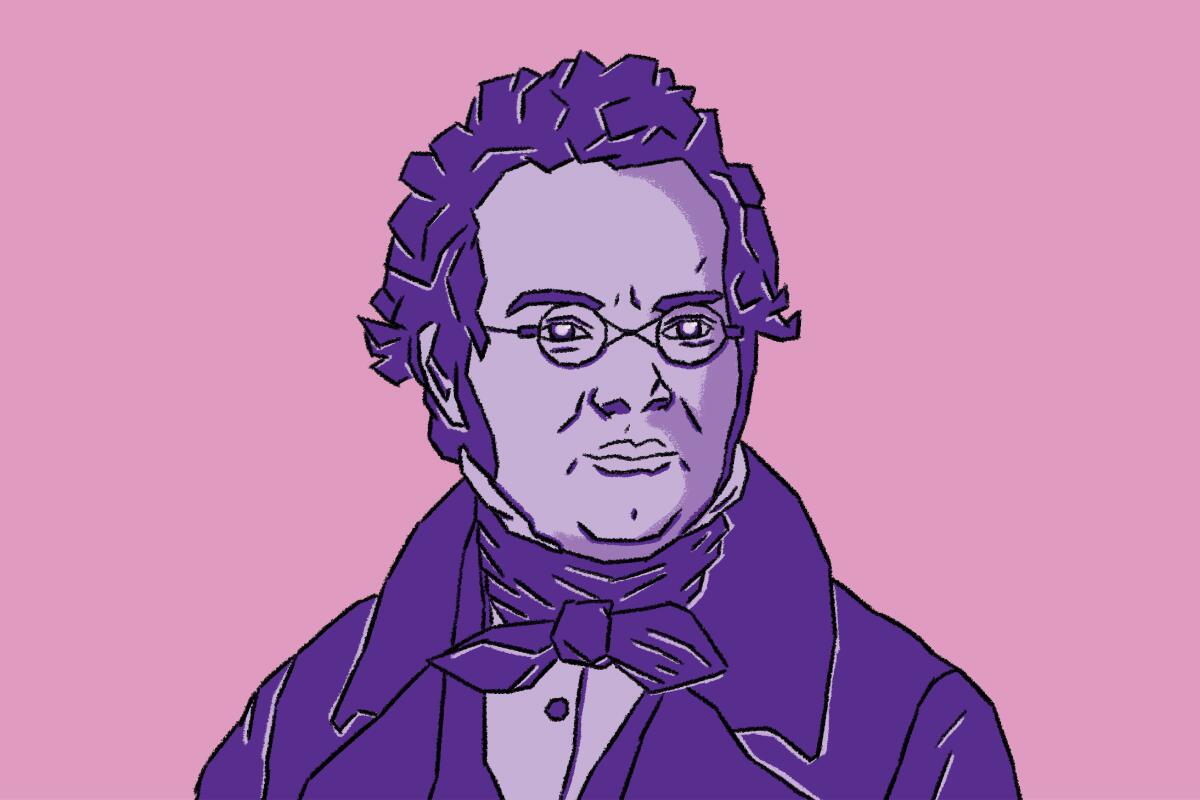In Schubert’s last sonata, the trill’s the thing

- Share via
When a chipping sparrow trills, it could be that spring has arrived. When women’s voices ululate, they do so, in different regions of the world, to celebrate, to mourn, to pray, to warn, to seduce. When Baroque music wants a little sexing up, a trill’s wavy glitter serves as reliable ornament. When signaling the onset of mystical transcendence in his late piano pieces, Beethoven vexes performers with finger-busting trills.
There are trills, and there are trills. But there are no trills like those in the first movement of the sublime piano sonata Schubert finished and performed two months before his death at 31. Miraculously, given that the composer was supposedly in the tertiary stage of syphilis, “there is in the Sonata in B-flat,” Philip Radcliffe noted in his small book on Schubert’s sonatas, “no place for terror.”
The sonata begins in a realm of heavenly harmony so secure in its delicious repose that nothing can detour its pleasure-giving capacity. Mysteriously interrupted by trills in the bass register followed by hesitating silence, the melody simply picks itself up as if nothing at all has happened.
Build Frank Gehry’s Colburn School concert hall. Renovate Disney Hall. Update the Dorothy Chandler Pavilion. The investments will pay off, big time.
This use of the trill obsesses pianists. We don’t know what it means, but presumably it serves as foreboding. It might, say, simulate the feeling in the pit in your stomach learning of a novel coronavirus terrorizing faraway Wuhan but telling yourself nothing like that could happen here. Just as easily, though, the trill can mimic the atmospheric enchantment of a foghorn off in the misty distance.
“It is the most extraordinary trill in the history of music,” Andras Schiff told the New Yorker five years ago, the day after playing the sonata with magisterial serenity at Walt Disney Concert Hall. For the Hungarian pianist, the trill sounded like a distant murmuring over a calm sea of an approaching storm.
There are any number of ways of playing this trill. When loud and slow, it is the first unsure seconds of an earthquake. Played soft and delicately as if flowing into a phrase ending, it is a cushioned resting place. The silence that follows when long is disrupting. When short, it’s for catching your breath. Each variation in between brings something different.
Schubert may or may not have known his time was extremely limited when he wrote the sonata. While syphilis was the likely cause of death, his doctors couldn’t say for sure. Death came so suddenly that typhoid fever was another possibility. It could have even been a dubious piece of fish he was served when he went out to dinner with friends in Vienna three weeks before his death, on Nov. 19, 1828. He became ill after a couple of bites and never recovered.
But what Schubert was keenly aware of was that, following the death of Beethoven the previous year, he had become the greatest composer in the world, and that all life, his in particular, was fragile. He wrote a huge amount of exceptional music in his last year. The B-Flat Sonata was his 21st for piano, the last in a triptych of major sonatas composed at the same time. He also wrote a luminous String Quintet in C, a leading candidate for the most gorgeous piece of chamber music of all time. There were flowing from his pen that year great songs galore, a rapturous mass, other memorable piano pieces and much more. He gave concerts, actively pursued publishers, musically socialized with his Schubertiads.
No composer — no artist of any kind, in fact, comes to mind — who did so much and with such mature vision, so young, in so little time on the cusp of death. Those trills and the silences that follow may hold the key. As the embodiment of uncertainty, they bring a listener dramatically into the present. We like to tell ourselves, for instance, that during the pandemic our lives are on hold, when it is nothing of the sort. Consciousness can never be on hold.
The B-flat Sonata, which is further known as D.960, the standardized numbering system for the Schubert’s works, has been called sublimely beautiful by just about everyone who comments on it, because it is. But even the impact of the sublimity depends on those pesky little reminders that nothing is permanent. As I write, 1,000-year-old trees are burning in California forest fires. The prospect of even their impermanence makes the trees outside our windows all the more precious.
Schubert’s Zen-level appreciation for the necessity of beauty as lived in the moment is the essence of this sonata on all levels. The second movement is lyrical sparkle, as starry a night as a keyboard has ever mapped, and as full of secrets. How is it that so little to go on as a broken accompaniment of a simple melody, a quick little flick of a finger in the right hand on the last beat of most measures, inspires contemplation of the vast beyond? Whence the spring in an ailing Schubert’s step in the Scherzo, to say nothing of a 31-year-old’s boisterousness in the Finale.
After the wondrous depth of feeling in the first two movements, Schubert has been accused of succumbing to what might be generously attributed as acceptance, or ungenerously (and more commonly) as mere superficiality. I think it neither but, instead, a remarkable clearheadedness, a Buddha response to seeing the world as it is.
Indeed, Schubert was the most Buddha-like composer to have come along before composers in the 20th century began embracing Buddhist thought (Wagner may be an exception, but no one ever called him, personally, Buddha-like). The same remarkable clearheadedness that allowed Schubert to trill without telling you why and making you listen anew, is the Schubert who found merriment where others found anguish.
When placed historically, this sonata’s achievement is even more exceptional. Unlike Beethoven, who kept pushing boundaries as he grew, stretching forms to his super-composer will, Schubert couldn’t waste what energy he had left on form, the shape of his music. It all went into structure and content, the newest wine in old bottles without very interesting labels.
He reverted to the regular classical four-movement sonata forms that were already becoming tired in the early 19th century when Romantic excess was the rage. Again, this was a spiritual ruse allowing him to constantly upset the expectations of the listener. It consequently took a century for the sonata to be appreciated.
There was too much assuredness in the art of the 19th century. The tumultuous 20th century, though, showed us in science, in philosophy, in world events, and expressed in art, how little is as it seems. Everyone plays Schubert’s Sonata in B-flat, D. 960 differently. Everyone hears it differently. Every time you listen, you are given the opportunity to discover something that was always right in there in front of you.
Given half a chance, and Schubert’s trills will haunt you. They will wile their way into your dreams. They will answer no questions, solve none of life’s riddles. They come with no guarantees for giving you peace of mind. But if you welcome a simple trill, the mere current produced by rapidly alternating two notes can subliminally and, yes, sublimely recharge your sense of wonder.
Starting points
Many a major pianist has recorded Schubert’s B-flat Sonata. Maurizio Pollini unleashes its glow. An early recording by the late Leon Fleisher, recorded when he was 28, has an irresistible vitality. Mitsuko Uchida is the soul of Schubert’s lyricism, while another Japanese pianist,Aki Takahashi, illuminates the unexpected. In his second recording of the sonata, Andras Schiff plays on a piano from Schubert’s time exposing primary musical colors that a modern grand mutes. Sviatoslav Richter recorded the sonata many times, always extremely slow, making it a mystical rite. Rudolf Kempff recorded the sonata twice and both times with unruffled insight, Schubert, you might say, unfiltered. Radu Lupu, Alfred Brendel, Marc-André Hamelin, Evgeny Kissin all have something valuable to say. Khatia Buniatishvili shamelessly caresses the sonata in a state of romantic ardor, and, don’t ask me how, almost outrageously gets away with it.
With live concerts largely on hold, critic Mark Swed is suggesting a different piece of recorded music by a different composer every Wednesday. You can find the series archive at latimes.com/howtolisten. Please support Mark’s work with a digital subscription.
More to Read
The biggest entertainment stories
Get our big stories about Hollywood, film, television, music, arts, culture and more right in your inbox as soon as they publish.
You may occasionally receive promotional content from the Los Angeles Times.












